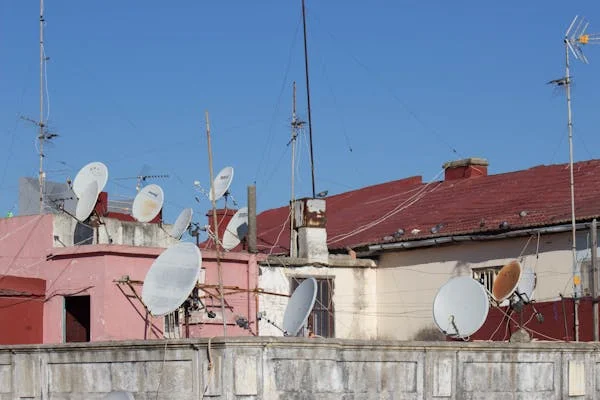As streaming services become more and more popular, many people forget that they can still tune in to free local channels on their TV with an antenna. Whether you want to catch the news, sports, or entertainment, you can do it free without a monthly bill. However, with all sorts of antennas available, it could be quite tedious to select the right one. This guide will explore points worth considering when picking the most suitable TV antenna for your home.
Learn the Types of TV Antennas
Prior to buying any antenna for indoor TV, one should have some basic common knowledge of the different types of antennas offered. These may be broadly categorized into indoor and outdoor antennas.
Indoors antennas are generally small, lightweight, and easy to install. They work best for those living in towns or cities; those closer to TV broadcast towers are generally used. You will usually want to position these antennas up by a window or high on a wall with the hope of receiving a decent signal. These do quite well in strong-signal areas; however, they are sometimes defeated if surrounded by interference such as tall buildings or hills.
Outdoor antennas have larger sizes; they are meant to be installed on the roof, attic, or with a pole outside. These antennas are perfect for people living far away from the TV towers or those who are in remote areas where the signals are weaker. Since they are situated in such a way to receive signals from above, reception is stronger and clearer. However, they tend to require more effort to set up and, in most cases, may require professional installation.
Any antenna depends on your area, especially if you have a long-distance or short-distance radio station. If you reside in the city, you may be okay with an indoor antenna. But if you live in an area far from any TV tower, you’ll be happier with an outdoor antenna.
Test Your Location and Signal Strength
Finding a good antenna starts with your location. The closer you are to TV broadcast towers, the better reception you will get. If one lives within 20-30 miles of a tower, then an indoor antenna should do well. However, if your abode is more than 50 miles away, an outdoor antenna is required.
Further, note that obstacles between your home and the TV tower may hinder signals, leading to some channels not being received. Buildings, trees, and hills at times block out the signals. If you live in such conditions where there are plenty of these hurdles, you may want to work with an amplified antenna or a rooftop installation.
Directional versus Omnidirectional Antennas
The two main designs of TV antennas are directional and omnidirectional. Knowing how they are different can help you decide on the right kind for your home.
Directional antennas are sharply-focused antennas constructed to receive signals from only one populated direction. They work excellently if the majority of your broadcast towers are located in the same direction as your abode. Directional antennas create a strong signal with concentrated capabilities to cancel interference from sources you’d prefer not to receive signals from. The downside is that they must be aimed at their service area in order to be useful. If you change houses or need to pull signals from more than one tower, you will have to rethink the direction of your antenna.
An omnidirectional antenna is one that receives signals equally well from all directions. It is ideal for places with several broadcast towers situated in different directions. Its non-pointing feature allows easy installation. However, when different signals come from different sources, they tend to interfere with other signals. In this case, the strength may not be as high as that of a directional antenna.
Amplified versus Non-amplified Antennas
Amplified antennas are useful for rural areas or places that experience interference, for example, on high-rise apartment buildings with thick walls. These can catch more channels and reduce instances when one loses the signal. However, an amplifier in an area of strong signal reception can generate interference and cause distortions in the reception.
In a location with strong signals, nonamplified antennas indeed work well and do not require an external power supply. If you reside close to TV towers, a nonamplified antenna usually should be enough. In situations of weak, unstable signals, an amplified antenna may make the difference.
Whenever selecting an antenna, determine whether you should have any amplification in your location; if uncertain, start with a non amplified antenna and follow with the amount of amplification from there.
Perfect Mounting for Efficient Reception
Placement of your antenna directly reflects its working capacity. Generally, for indoor antennas, the best places to put them for reception include somewhere near a window or high on a wall. Keep away from putting antennas behind a TV set, or too close to electronic devices back or inside a closet, as these could introduce interference. If the signal reception seems weak, consider moving the antenna elsewhere or adjusting to a different room.
Outdoor antennas are best mounted on the roof or a high pole. A high antenna will generally find a clearer path to the signal. If possible, align the antenna in the direction of the nearest TV broadcast tower, and this will increase the signal reception.
An adjustment in the angle of the antenna or changing the direction may be worth a try if your signals seem weak. Extremes in position sometimes make a huge difference in reception.
Read Reviews and Compare Brands
To be on the safe side, read the reviews from customers who previously bought a TV antenna and compare several brands. Some common things to look out for include signal quality, the kind of durability expected, and how easily the antenna can be installed. As for examples, Mohu, ClearStream, RCA, and Antennas Direct are brands with an impressive reputation, manufacturing steady antennas.
Comparing features and pricings helps you find an antenna that fits your need within your budget. Check the return policies in case the antenna is not working up to par.
Conclusion
Choosing the right TV antenna depends on your location: the type of reception; strength of signals within the receiving area; acceptable distance; and convenient installation. You can expect an indoor antenna to work just as fine in an urban area, while rural places would require an outdoor antenna. When deciding on how to plan your preference, range, bonne direction, and amplifier usage are important considerations.
It is these important facts that shall lead you to acquire the best antenna for your home and thus view unlimited high-quality TV, free of any monthly charges.





